Not a lot of people know this, but I was raised with two religions: my dad’s side of the family is Jewish and my mom’s side of the family is Catholic. Growing up, this meant that my brother and sister got lavish Bar/Bat Mizvahs, while I went through the motions of First Holy Communion and confirmation. We celebrated both Christmas and Hanukkah (there were some years in which, out of pure laziness, we would half heartedly celebrate a combination of the two with both a Christmas tree and a menorah at the same time — a form of Chrismukkah, before The OC popularized the word), Passover and Easter. My mom and I would start the week with Passover seder at my aunt and uncle’s house with my dad’s family to help light candles and drink wine, before ending the week at church to wave palms and find easter eggs. However, as I grew older and formed my own identity, the traditions and rituals from both sides fell away.
When I was living in San Francisco, an acquaintance of mine was delighted to find out about my Jewish side (I suppose my decidedly Asian features don’t really scream “Jewish”) and invited me to her annual Passover celebration. I initially declined, saying that it had been years since I’d even stepped foot in a synagogue (or church, for that matter), or even celebrated any kind of religious holiday from either religion. She waved me off — “We don’t really do Passover like our parents. Think of it as an old-school seder with new-school flavors.”
Her description intrigued me. Passover seder at my aunt and uncle’s tended to be a solemn, traditional affair. There would be several readings from the Haggadah in HEBREW (because both my dad and uncle are crazy and can actually speak Hebrew), four glasses of prune juice that somehow made my mouth dry, and an argument with my sister about who would get to ask the question about why this night is different from all other nights. Dessert would be hidden away for us children to find, and when we did, it wasn’t dessert at all — it was a plain matzo cracker.
Showing up at her apartment, I wasn’t sure what to expect. But I was pleased to see most of our non-Jewish mutual friends there, and even more pleased that we were all dressed casually in jeans and flipflops. Indie music played in the background as we took our places around the floor, sitting crosslegged Indian style. Our hosts handed out coffee mugs of red wine, and we had spirited discussions about the symbolism behind the food on the Seder plate, a paper plate holding sprigs of parsley, celery and a chicken bone. We took turns passing around a mug of salt water, dipping the sprigs of parsley into the water (twice) and wrinkling our noses at the herb’s bitterness. The evening was decidedly nontraditional, but pleasant and true to the spirit of a Passover seder.
When dessert was announced, however, I almost cringed — I wasn’t looking forward to an adult version of the game where we had to find the broken matzo cracker, expecting a scenario in which a dozen tipsy twenty-somethings tore through our hosts’ cramped apartment in an attempt to find the afikoman. Instead, our hosts brought out a tray of matzo cracker shards, drizzled in dark chocolate. Matzo chocolate crunch, my friend explained, raising her eyebrows at my astonishment. I took a bite. It was delicious.
That night was the first night I’d ever had matzo chocolate crunch. It seems silly to say this now, but for me, the matzo chocolate crunch was revolutionary. I mentioned earlier that I had let the traditions my parents raised me with fall through the cracks. One of the reasons was because, as I grew older, my family’s old fashioned seder dinners just seemed so quaint, traditional, and increasingly irrelevant in my fast-paced, modern life. But attending that dinner and eating that updated dessert of matzo chocolate crunch, it occurred to me that it was possible to keep those old traditions that my family raised me with, but make them new and relevant again.
So with that, I’m making my own version of the matzo chocolate crunch. My version, however, is an ode to Samoas, my favorite Girl Scout cookie:
Toasted coconut, salted chocolate, and crunchy caramel layer several matzo crackers to create a crunchy, spectacular treat that combines both old and new flavors. It’s not the traditional seder dessert from my childhood (that is, a plain matzo cracker), but it’s one that’s perfect for me now. Be sure to use kosher salt, vanilla extract, and dessicated coconut if using for Passover. Chag sameach!
Some baker’s notes:
-
- Time for some history and food science. During Passover seder, it’s traditional to eat matzo that’s only made of flour and water, with no leaveners like yeast or dairy additives like milk and eggs. After all, Passover is a commemoration of the Jewish exodus from Egypt. The Haggadah narrates that the Israelites left Egypt in such a hurry that they could not wait for their bread dough to rise; the resulting bread, when baked, was matzo. As a tribute, breads that have had contact with water or any kind of moisture for longer than 18 minutes is prohibited during Passover. Why 18 minutes? Because that’s when flour and water start to begin their leavening process. Dairy like milk and eggs is also avoided because adding them to flour and water tends to speed up the leavening process.
-
- If you’re making this for strict, kosher passover, I’ve already noted that you need to use kosher salt, vanilla extract and coconut. The recipe as is also uses butter, which you can swap out with margarine.
- Can’t find matzo crackers? Matzo is available online and in most grocery stores around Passover/Easter time. If it’s not the season, you can also use plain crackers or saltines instead.
Get the Recipe: Samoa Cookie Matzo Crunch
Ingredients
- 1/2 cup desiccated coconut flakes
- 4 to 6 sheets unsalted matzo crackers
- 1 cup (2 sticks) unsalted butter, cut into 1-tablespoon chunks
- 1 cup light brown sugar, firmly packed
- 1/2 teaspoon pure vanilla extract
- 1 cup semisweet chocolate chunks (chips work too!)
- 1 tablespoon flaky sea salt
Instructions
- First, toast the coconut flakes. Transfer 1/2 cup desiccated coconut flakes into a frying pan over medium heat. Use a heatproof rubber spatula to move the coconut flakes around as they toast. Watch them carefully — at first it will seem like nothing is happening, but they start to get brown and fragrant all at the same time. Brown to your liking and set aside.
- Center a rack in the oven and preheat to 375 (F). Line a rimmed 11 by 17-inch baking sheet completely with foil, making sure that the foil goes up and over the edges. Cover the foil with a sheet of parchment paper, before lining the sheet with 4 to 6 matzo crackers. Break extra pieces as necessary to fill in any spaces.
- In a medium, heavy-bottomed saucepan, combine 1 cup unsalted butter cubes and 1 cup firmly-packed light brown sugar. Cook over medium heat, using a heatproof rubber spatula to stir until the butter is completely melted and the mixture is beginning to boil. Boil for 3 minutes, stirring constantly. After 3 minutes, remove from heat and stir in 1/2 teaspoon pure vanilla extract until fully incorporated. Pour the mixture over the matzoh and use your heatproof rubber spatula to spread it evenly over the crackers.
- Transfer the pan to the oven and reduce the heat to 350 (F). Bake for 15 minutes. As it bakes, it will bubble up — this is fine, but make sure it’s not burning or browning too quickly. If it is in spots, remove from oven and reduce the heat to 325 (F), before replacing the pan in the oven.
- Once the matzo has baked for 15 minutes, remove from oven and transfer to a wire rack before immediately covering with 1 cup semisweet chocolate chunks. Let stand for 5 minutes to melt and soften, before using an offset icing spatula to spread evenly over the matzo crackers. Once the chocolate is spread evenly, sprinkle evenly with the 1/2 cup toasted coconut (from the 1st step) and 1 tablespoon flaky sea salt.
- Let cool completely before breaking into pieces. Store in an airtight container until ready to serve. The crunch should keep well for about 1 week.

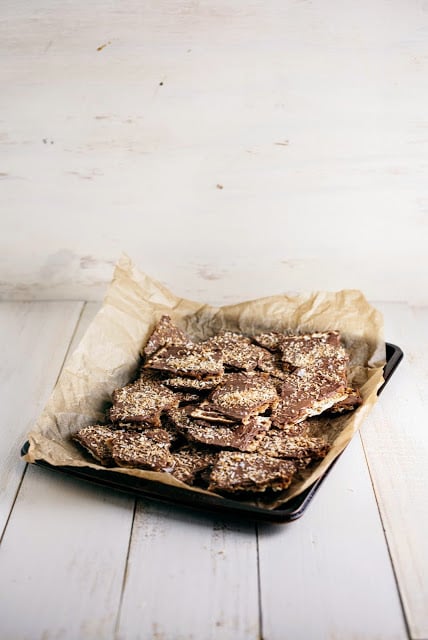


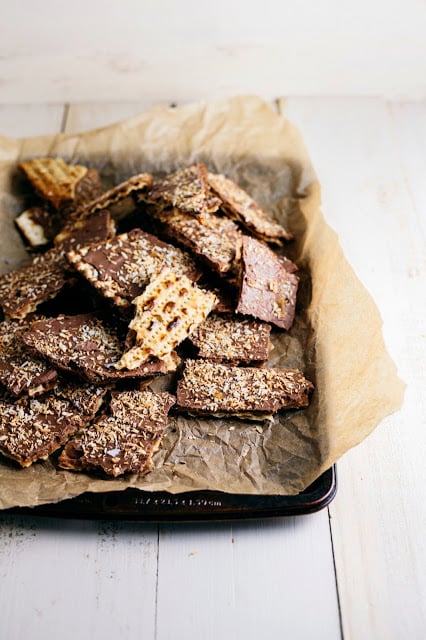
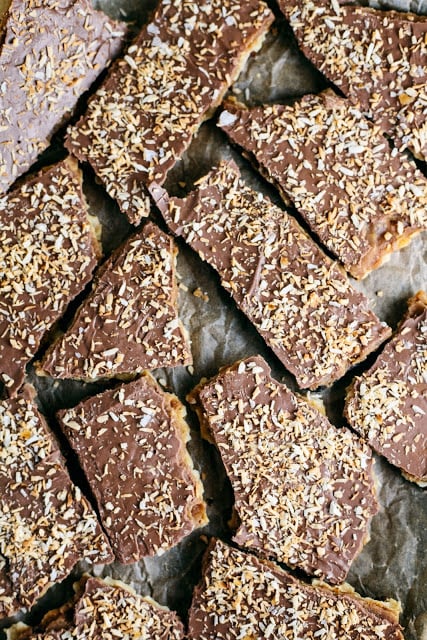
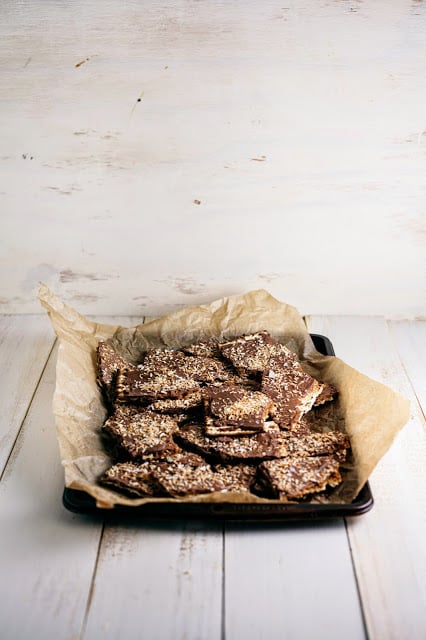
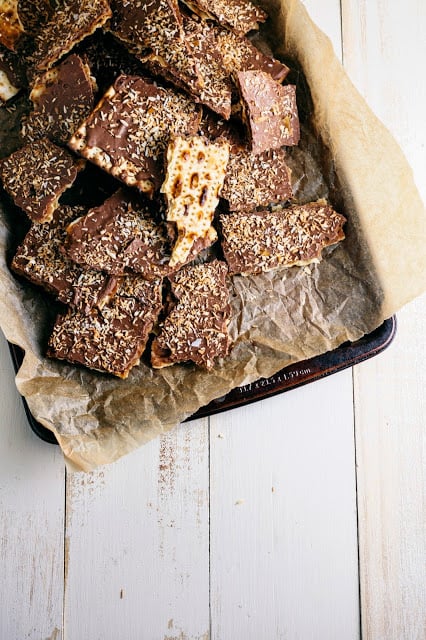
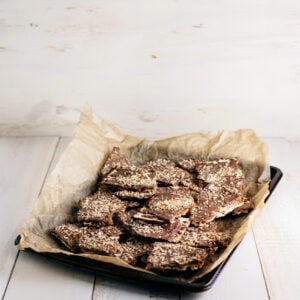

THIS. IS. EVERYTHING!
and YAY for religious mutts!! wasn't it fun growing up with chrismukkah? 😉
Want to know something weird? I've always wanted an excuse to eat matzo!!! But I mean I have straight up zero ties to Jewish culture so…there's that. I'm pretty sure I'm going to feel like a total phony buying matzo in the store when I finally do work up the nerve, but it's going to happen SOMEDAY!!! Your photos, as always, are beautiful and I loved hearing about your non-traditional celebration! Spirited discussions around the symbolism of food? Sign. Me. Up.
You should try Matzo Pizza, just put some pizza sauce, toppings and cheese on one and put in oven/toaster oven till cooked through. They are good
This is so awesome. Must try. Although, it makes me want GS cookies!
What a beautiful story, and the recipe looks fantastic!!!
There's something so soothing about your writing–it's the voice that emerges when you're describing that unfamiliar but intimate blending of cultures, and it gets me pumped to sit down and do my own writing. Hooray for blog inspiration (: And saltine/matzo cracker crunch is a fabulous combo, always. So glad you shared this, Michelle! Off to write some more…
This looks amazing!! I love the added coconut and the thick, thick pieces. Love!
Matzo Crack! There seems something wrong with the world that I was only introduced to this delicacy as an adult. It definitely contributes to making Passover my favorite holiday (along with my friends, wine, and the food – even the parsley). For what it is worth, I'm Noah's sister and I adore his guest appearances. And your recipes without him.